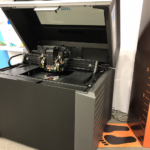
 Metal 3D printing is a constant work in progress. For all that it’s capable of, it still is plagued by issues, with parts being prone to flaws and imperfections. But plenty of researchers are dedicating their time and energy towards detecting and preventing the problems behind those flaws and imperfections, using advanced technologies to delve deep into metal 3D printing processes. Currently, scientists at the Department of Energy’s SLAC National Accelerator Laboratory are using X-rays to study the process and try to understand where flaws in metal 3D printed parts come from, and how those flaws can be prevented.
Metal 3D printing is a constant work in progress. For all that it’s capable of, it still is plagued by issues, with parts being prone to flaws and imperfections. But plenty of researchers are dedicating their time and energy towards detecting and preventing the problems behind those flaws and imperfections, using advanced technologies to delve deep into metal 3D printing processes. Currently, scientists at the Department of Energy’s SLAC National Accelerator Laboratory are using X-rays to study the process and try to understand where flaws in metal 3D printed parts come from, and how those flaws can be prevented.
“With 3-D printing, you can make parts with very complex geometries that are not accessible for casting like regular metal parts,” said SLAC staff scientist Johanna Nelson Weker, who is leading the project. “Theoretically, it can be a quick turnaround – simply design, send, print from a remote location. But we’re not there yet. We still need to figure out all of the parameters involved in making solid, strong parts.”
The project is taking place at SLAC’s Stanford Synchotron Radiation Lightsource (SSRL) in collaboration with scientists from Lawrence Livermore National Laboratory (LLNL) and Ames Laboratory.
In industries such as aerospace and automotive, parts need to be perfect – any imperfection can lead to a dangerous situation. That’s why each part, along with the 3D printers that make the parts, need to be put through rigorous qualification before they can be accepted for use. But if we could better understand the metal 3D printing process and ensure that flawless parts were reliably coming out of the printers, less testing would be needed, bringing the cost of metal 3D printing down.
One common flaw in metal 3D printed parts is the formation of pits, or weak spots. Pits are caused when the metal cools and hardens unevenly, and the scientists are currently trying to figure out how to prevent that from happening. They’re analyzing every part of the process, including the type of metal, the level of heat from the laser, and the speed at which the metal heats and cools, to find the best combination for eliminating pits and controlling the microstructure.
“We are providing the fundamental physics research that will help us identify which aspects of metal 3-D printing are important,” said Chris Tassone, a staff scientist in SSRL’s Materials Science Division.

Observing a part while it’s being 3D printed isn’t enough to see how deeply the laser is melting the layers of metal powder. The researchers tried imaging the layers with thermal radiation, but that didn’t give them enough information to tell what was causing the weak spots. X-rays turned out to be the perfect answer, letting the scientists see inside the layers as they’re being printed. They’re currently using two different types of X-ray methods. One creates micron-resolution images of the layers as they build up; the other bounces X-rays off the atoms in the powder to analyze its atomic structure as it changes from solid to liquid and back during melting and cooling.
The scientists also plan to study directed energy deposition processes, and they want to add a high-speed camera so that they can collect photographs and video and correlate what they see with their X-ray data. This is valuable for manufacturers and researchers who use cameras to observe the 3D printing process but don’t have access to an X-ray synchrotron.
“We want people to be able to connect what they see on their cameras with what we are measuring here so they can infer what’s happening below the surface of the growing metal material,” said Nelson Weker. “We want to put meaning to those signatures.”
Other researchers working on the project include Kevin Stone, Anthony Fong, Andrew Kiss and Vivek Thampy. The research was funded by the DOE Office of Energy Efficiency and Renewable Energy’s Advanced Manufacturing Office.
Discuss this and other 3D printing topics at 3DPrintBoard.com or share your thoughts below.
[Source: SLAC]
If you're looking to get architectural 3D animation in the USA, our service provides an exceptional way to bring your architectural concepts to life through dynamic, immersive visuals. Through our platform, you can easily request high-quality 3D animations that showcase your designs in motion, offering a detailed view of your project from multiple angles and perspectives. Whether it's for a real estate development, a commercial building, or an urban planning project, our expert team ensures that every detail is captured in a visually compelling animation.
Through our website, you can seamlessly get architectural 3D animation tailored to your project’s specific needs. With our help, you can offer potential clients or investors an engaging experience that goes beyond static images. By integrating CGI animations with real-world settings, lighting, and textures, our team creates a lifelike experience that allows your audience to interact with your project as though it were already built. This service is perfect for presenting complex designs in a clear, visually attractive way that stands out in the competitive architectural market.




